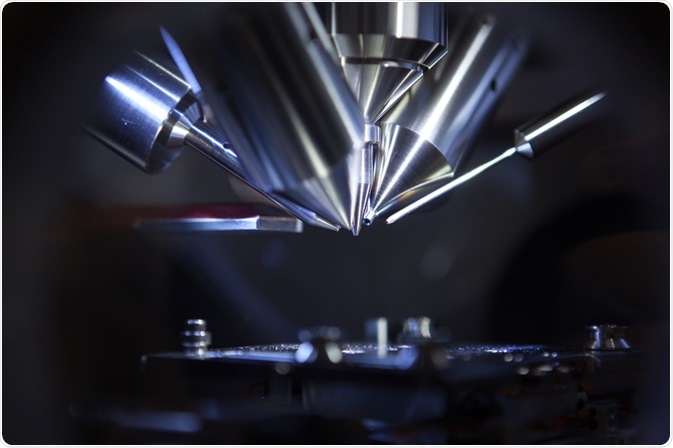The science of proteomics began in 1975 with the study of proteins in Escherichia coli (E Coli). The term “proteomics” was coined by Marc Williams in 1994. Proteomics is a branch of molecular biology which studies the proteins in an organism's genome.

Mass Spectrometer Time of Flight. Image Credit: Intothelight Photography/Shutterstock.com
A proteome is the entire collection of proteins in an organism and is a more in-depth description of the genome. By studying the proteome we can get a more in-depth understanding of:
- How cells adapt to environmental signals.
- How cells differentiate during the development of an organism.
- How a disease might progress in an organism.
- Cellular responses to aging in an organism.
- The difference in physiology, disease susceptibility, response to environmental influences, and how an individual might respond to treatment.
- Many other possible phenomena.
In short proteomics analyses the structure and function of biological systems.
One of the challenges of proteomics is to extract and analyze proteins and peptides without degrading them. Advances in Mass Spectrometry have greatly helped the development of proteomics and it is now possible to carry out qualitative and quantitative analysis on complex mixtures without degrading the proteins which have added greatly to the understanding of how cells work. The study of proteomics gives more information than the study of genomics, for example, the protein in a cancerous cell could differ from the protein in a healthy cell but the genes of both could be the same.
Improvements in the technology and new techniques have allowed greater and greater sensitivity to proteins to be developed allowing for greater scope for studies. Mass spectrometry has become the core technology in proteomics. New strategies have allowed highly complex mixtures to be analyzed with a relatively high throughput rate to determine proteins and peptides present. Combining high-performance mass spectrometry with highly efficient chromatographic and electrophoretic separations has enabled rapid qualitative and quantitative analysis of thousands of proteins from minute samples of biological materials.
Types of Mass Spectrometry in Proteomics
The application of mass spectrometry to protein analysis has been revolutionized in recent years by the development of new techniques such as:
- MALDI – Matrix-Assisted Laser Desorption/Ionisation where lasers are fired at a sample and ESI Electro Spray Ionisation which are both used to generate gaseous samples of large molecules without the degradation associated with heat.
- SELDI Surface-Enhanced Laser Desorption/Ionisation which is similar to MALDI but the sample is fixed to the surface before Mass Spectrometry.
- LA ICP MS – Laser Ablation Inductively Coupled Plasma Mass Spectrometry is another new technique where a laser beam is focussed on a surface to generate fine particles for analysis The particles are further excited into an inductively coupled plasma before being analyzed by mass spectrometry. This technique allows analysis down to ppb (parts per billion) without any special sample preparation. Sample down to femtograms (10-15 grams) can be analyzed.
Techniques such as laser desorption/ionization and the introduction of multi-stage and 'hybrid' analyzers able to generate previously unknown amino acid sequence information and the interfacing of mass spectrometry with protein databases have resulted in entirely new possibilities of protein study and identification. Increased sensitivity allows minute amounts (femtomole, 10-15 moles to attomole 10-18 moles levels) of protein and protein building blocks to be identified, improving core knowledge of modern proteomic science.
These techniques help in allowing scientists to get detailed knowledge of an organism’s genome and to study how a disease or condition will progress. Being able to study proteins within a cell allows for knowledge that may lead to treatments. For example, the proteins in a cancerous cell may be different from a healthy cell so the abnormal protein could be detected and treatments devised.
Mass spectrometry may also allow for novel medicines and vaccines to be developed. For example, mRNA (messenger RNA) vaccines have been developed relatively quickly for the SARS-CoV-2 virus as the mRNA in proteins making up the virus can be identified and targeted.
Mass spectrometry has also become the main technology for the characterization of food proteins and peptides. The application of mass spectrometry-based techniques to the qualitative and quantitative analysis of the complex protein mixtures contained in foods can play a decisive role in the understanding of their nature, structure, functional properties, and impact on human health. Proteomics can also be used to track changes in food during processing and to check food quality.
Mass Spectrometry based strategies applied to food and nutrition proteomics are now capable of addressing many analytical questions which including issues related to food quality and safety, certification, and traceability of products. It is also able to determine the structural and functional relationship of food proteins and peptides. These different aspects are interconnected and can be effectively understood and made clear only by the use of integrated, up-to-date analytical approaches. The application of mass spectrometry and proteomic technologies to the structure and function of food proteins allows scientists to focus on issues related to their detection, identification, and quantification, relevant for their biochemical, technological, and toxicological aspects.
Global Applications of Proteomics
Proteomics is most used in medical applications but is increasingly finding applications in the food industry and other applications. The global market for proteomics products and services in 2019 was estimated at US$21 billion and it is expected to grow to US$50billion in 2027. Some of the key players operating in the proteomics market include Agilent Technologies Inc., Danaher Corporation, LI-COR, Inc., PerkinElmer, Inc., Thermo Fisher Scientific, Inc., HORIBA, Ltd., Bio-Rad Laboratories, Inc., Bruker Corporation, General Electric (GE), Waters Corporation, Becton, Dickinson and Company, Caprion Biosciences, and others.
Many academic institutions and medical companies are studying proteomics and the commercial applications in the food, chemical cosmetics, and other industries are likely to grow massively with increased knowledge and understanding facilitated by the improved capabilities offered by mass spectrometry and other technologies.
Further Reading